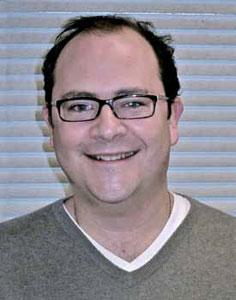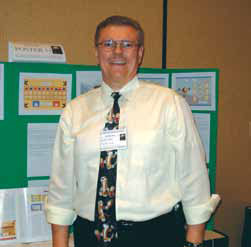Leader of the Year Winners

While the concept of leadership can be fuzzy sometimes, the winners of 2010’s Leader of the Year awards are clearly groundbreakers. From the nitty gritty of classroom instruction to back office decision-making, each has shown that innovative thinking and decisive action, can make a huge difference in the success of students. We found the stories of these three education leaders to be inspiring. We think you will too.
—The Editors
Making the Right Connections
BRIAN MANNIX
Seventh-grade social studies teacher Great Neck South (NY) Middle School

Never doubt your students or their ability to help.
That’s Brian Mannix’s motto. As he says, “The more faith you have, and the more you turn that over, the easier your job becomes.”
This social studies teacher practices what he preaches. As he develops challenging interdisciplinary projects infused with technology, he relies on the students to lend a hand. “The kids with more tech experience have been fantastic at helping their peers. I’m amazed at how many of them log on to Edmodo [a private passwordprotected social-learning network for schools] to give advice. There are twins who go on every night and beg people to ask them questions about homework.”
Mannix collaborated last year with his team teachers (English and science) on a Connected Classroom project. Now the three are testing it before it is rolled out school-wide. In an uncanny case of perfect timing, when Mannix brought the proposal to the technology committee, there was leftover money and the project was born.
Tools and ideas to transform education. Sign up below.
Over the summer, the committee invested $20,000 in Dell Netbooks and Apple iPod touches for one-to-one and one-to-two connectivity, respectively. So far, Mannix’s classes have done a colonization project with schools in New Jersey and South Carolina, communicating via Skype and wikis. They are learning about digital citizenship through Digi Teen Project, a program that links 11 schools all over the world. “We have turned our classroom into a paper-free environment,” Mannix brags.
Mannix shares the highs and lows with his colleagues through staff development and informational sessions. He and his team discuss their lessons and offer resources. Later he will develop a course covering the most intriguing and replicable elements of The Connected Classroom.
Another schoolwide project that incorporates technology creatively is the student-made documentary and awards show called “The A-Kid-emy Awards.” Mannix developed this project in collaboration with his fellow team members, the librarian, and the technology assistant.
“Last year we asked, ‘What is the greatest challenge facing the U.S. today?’” he notes. Topics included the economy, terrorism, drugs, and smoking. Students were broken into groups; each group chose a challenge and spent about two months making a documentary with iMovie. Some days they worked on it during social studies, other days in their English classes. They conducted interviews and performed research after school. The culmination was an Academy Awards–like celebration with a “mocktail” hour. Students handled the invitations, the music, and the brochures, and many wrote acceptance speeches in English class. “It was the best project I’ve ever done as a teacher,” Mannix says.
Mannix says the most important lesson he’s learned is this: “You have to teach with technology and not save it for a separate class. It must be part of the everyday experience.”
Tools He Uses
¦ Apple iMovie
¦ Dell Latitude 2110 Netbooks
¦ Digi Teen: Digital Citizenship for Teenagers (digiteen.ning.com)
¦ Edmodo (edmodo.com)
¦ Flip video cameras
¦ Geocaching (www.geocaching.com)
¦ Google Docs (docs.google.com)
¦ Google Sites (sites.google.com)
¦ iPod touches
¦ PBworks: Online Collaboration (pbworks.com)
¦ YouTube (www.youtube.com)
Access Granted
JULIE CARTER
Executive director of technology Minnetonka (MN) School District

If you can’t get access to the technology, what good is it?
That’s the question underlying Julie Carter’s ambitious plan to allow her teachers to personalize education to meet each child’s unique needs.
In 2002 and 2007, district voters approved a referendum levy for technology and instructional equipment. The funding accelerated Minnetonka’s vision for technology integration from 11 classrooms in 2002 to more than 400 classrooms in 2009.
To incorporate technology into every aspect of her district, Carter has done four key things. First, she figured out how to put the most computers into students’ hands. “Instead of a one-to-one laptop program, we focused on one-to-one access,” she says. “Depending on the nature of the project, a student might need a thin client, a laptop, or a video-production desktop. We make sure the right tool is available for when it’s needed.”
Carter turned to thin clients as a low-cost, low-maintenance solution for computers. Currently there are 745 thin-client devices in classrooms and media centers at the elementary and middle schools. “The huge cost savings and the reduced maintenance effort have changed our workload dramatically. If something does go down, we unplug the box and plug in a replacement. There’s no reimaging or sending staff in to find out what’s wrong. It continues to make sense.”
Carter’s second way to provide access was the laptop-loaner program. “Although a high percentage of our families have Internet access at home, we had to figure out how to provide it for those who did not,” she says. “Students collaborate online at night and work on projects.”
At this time, 50 families (identified by school principals) have been given laptops to use for the school year. The district asked Verizon for discounted Internet service and pays the monthly $27 charge for unlimited broadband access. “We are so happy to be able to provide these laptops,” Carter says. “They are getting lots of great use.”
The third tier of her plan was to create MyMinnetonka, a portal for students, parents, and staff. Users log on to look up grades and attendance or access the Blackboard eLearning tool and other Webbased applications. Most homework assignments, as well as video clips, resources, and handouts, are posted online as well. In addition, students can get online versions of their textbooks, listen to podcasts, post on discussion boards, and study.
Last but not least, Carter opened a guest wireless network at the high school so that students can bring in and work on their own laptops, smartphones, iPods, and other devices. “Our goal is to leverage the technology they have in their pockets and backpacks,” she says. “We’re using this system to get more students online without any additional cost.”
Carter believes that technology accelerates learning, and that’s what drives her to make sure kids have anywhere, anytime access and a standard set of tools. “It makes learning relevant and interactive for everyone,” she says. “There’s no other way to do it. It’s such an exciting time to be part of education.”
Tools She Uses
¦ Blackboard
¦ Blackboard Connect-Ed
¦ BrainPOP
¦ Dell desktops
¦ Dell and HP netbooks
¦ Destination Reading
¦ Discovery streaming
¦ Finale NotePad
¦ Google SketchUp
¦ Pinnacle Analytics
¦ Projectors
¦ Scanners
¦ Scratch
¦ Skyward
¦ SMART Boards
¦ SMART student-response systems
¦ SMART document cameras
¦ Wyse thin clients
Steady Planning Yields Results
KEVIN M. ANDERSON
Assistant superintendent for teaching and learning Oak Park (IL) Elementary School District 97

How do you move a school district forward? Patience, people, persistence, partnerships, and teamwork.
According to Kevin M. Anderson, this is the philosophy that, in five years, took his district from outdated computers, various operating systems, and an understaffed tech department to a high-functioning district where teachers use Web 2.0 tools on a fiber network. What’s more, he did it on a shoestring budget.
From the technology committee that he filled with members of the community, parents, technology experts, staff, and teachers to the fiber network he put in place, Anderson executed his plan one step at a time. “When I started, in 2005, the district had gone through several years of budget cuts, especially in instructional technology,” he says. “The budget had been reduced to $1 million to cover 5,000 students and 450 staff members.
In 2006, the district realized that it had to update its technology, so Anderson began to figure out how to do it wisely and affordably. Because software and hardware had been purchased haphazardly, he leased eMacs for classrooms and labs. It was the first time the district had a common operating system. He standardized software and invested in Discovery streaming.
The next year, Anderson formed a TechVision 97 committee to establish a set of goals that would form the basis of all future technology plans. The team decided to invest in a fiberbased infrastructure. At the same time, a group of 15 teachers became the district’s first digital leaders.
Throughout all this planning, Anderson continually sought input from all stakeholders, including the teachers’ union.
When a new technology administrator came on board, Anderson put together a five-year 21st-century tech plan. The $6 million price tag for oneto- one was too steep, so he decided to focus on teachers. “With laptops and projectors, they can use Google Docs and other Web resources,” he says. He leased Dell laptops and bought netbook carts for the middle schools. Thanks to stimulus money, he was also able to purchase several projectors.
Professional development is executed as carefully as everything else. When teachers received their new laptops, last summer, they were paid to attend a six-hour course, three hours of which were dedicated to teaching in a one-computer classroom.
Finally, Anderson worked to restructure the technology department. In 2005, there were two teacher leaders. Today three full-time teacher leaders handle planning and workshops, two technology integrationists do software training and some repairs, and six technology specialists fix everything. A team of 45 teachers serve as digital leaders; they handle the training for inservice days and serve as a think tank for the entire department.
Tools He Uses
¦ Atomic Learning
¦ Classroom Suite from IntelliTools
¦ Dell laptops
¦ Dell Netbooks and carts
¦ Destiny Library System
¦ ELMO document cameras
¦ Epson LCD projectors
¦ Google Apps
¦ Inspiration
¦ iPads
¦ iPod touches
¦ Kidspiration
¦ Lexia Reading
¦ Microsoft Office
¦ Photoshop Elements
¦ PowerSchool and PowerTeacher
¦ Read 180
¦ Read Naturally
¦ SMART Boards
¦ SMART Tools
¦ Skype
¦ VoiceThread
